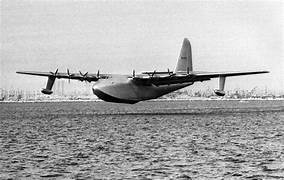In 1947, the United States witnessed the remarkable flight of a massive aircraft known as the Spruce Goose. This aviation marvel, officially named the Hughes H-4 Hercules, was the brainchild of industrialist and aviator Howard Hughes. The Spruce Goose's flight remains a significant moment in American aviation history, showcasing both technological innovation and the ambition of its creator. The Spruce Goose was an enormous flying boat, designed to transport troops and equipment during World War II. Its construction began in 1942, and it was made primarily of wood due to wartime material shortages, with the main structure crafted from laminated birch and spruce. However, by the time the Spruce Goose was completed in 1947, World War II had ended, and the need for such a massive aircraft had diminished. Nevertheless, Hughes was determined to prove the capabilities of his creation and to challenge the perceptions of what was possible in aviation. On November 2, 1947, the Spruce Goose took to the skies for its first and only flight. Piloted by Howard Hughes himself, the aircraft lifted off from the waters of Long Beach Harbor in California. The flight lasted approximately one minute, during which the Spruce Goose reached an altitude of 70 feet and traveled around a mile. Although the flight was relatively short, it was a significant achievement for the Spruce Goose. The aircraft's massive size, with a wingspan of 320 feet and a length of 218 feet, made it the largest airplane ever built at the time. Its successful takeoff and brief flight demonstrated the engineering prowess behind this colossal flying machine. The Spruce Goose's flight captured the imagination of the American public and garnered widespread media attention. It symbolized the spirit of innovation and the pursuit of technological advancement that characterized the post-war era. The aircraft's unconventional design and use of wood as the primary material showcased Hughes' ingenuity and determination to push the boundaries of aviation. Following its inaugural flight, the Spruce Goose was retired and placed in storage. Despite its impressive performance, the aircraft never entered full-scale production. However, it remains an iconic symbol of American engineering and a testament to the ambition and vision of Howard Hughes. In 1982, the Spruce Goose found a permanent home at the Evergreen Aviation & Space Museum in McMinnville, Oregon. Today, it is one of the museum's most popular exhibits, attracting visitors from around the world who marvel at its immense size and historical significance. The Spruce Goose's legacy extends beyond its one and only flight. It serves as a reminder of the importance of pushing boundaries, taking risks, and embracing innovation. The aircraft's construction and brief moment in the sky paved the way for future advancements in aviation technology and inspired generations of engineers and aviators.
2 November 1947 U.S.A. — The Spruce Goose
